Servicios Personalizados
Articulo
Latin American applied research
versión impresa ISSN 0327-0793
Lat. Am. appl. res. vol.42 no.4 Bahía Blanca oct. 2012
Free Convective Elastico-Viscous Fluid Flow With Heat and Mass Transfer Past an Inclined Porous Plate in Slip Flow Regime
R. Choudhury† and D. Dey‡
† Department of Mathematics, Gauhati University, Guwahati-781 014, Assam, India.
E-mail: rchoudhury66@yahoo.in
‡ Department of Mathematics, Girijananda Chowdhury Institute of Management & Technology, Guwahati-781 017 Assam, India. E-mail:debasish41092@gmail.com
Abstract — The unsteady free convective elastico-viscous fluid flow past a porous inclined plate in slip flow regime in presence of periodic temperature and concentration has been analyzed. The suction at the plate is assumed to be fluctuating with time. The governing equations of the problem have been solved by using perturbation scheme. The approximate solutions have been derived for the velocity, temperature field, concentration field, skin friction, rate of heat transfer and rate of mass transfer. The values of the skin friction co-efficient are calculated numerically and presented in tabular form for various values of the flow parameters. The influence of visco-elastic parameter with the combination of other flow parameters on the velocity field have been obtained and illustrated graphically.
Keywords — Elastico-Viscous; Free Convective; Perturbation Scheme; Inclined Plate and Skin Friction.
I. INTRODUCTION
The problem of free convective heat and mass transfer flow of viscous fluid has attracted the interest of many researchers because of its applications in aeronautics, fluid fuel nuclear reactor, chemical process industries and in different engineering fields.
Ostrach (1953) gave the various aspects of natural convection heat transfer. Ostrach (1954) also studied the combined effect of natural and forced convection laminar flow and heat transfer of fluids with and without heat sources in channels with linearly varying wall temperature. Gebhart and Pera (1971) analyzed the problem of vertical natural convection flows resulting from the combined buoyancy effects of thermal and mass diffusion. The behavior of viscous dissipation on unsteady free convective flow past an infinite vertical porous plate with constant suction has been discussed by Soundalgekar (1972). Berezovsky et al. (1977) studied the free convection effects on a vertical semi infinite plate. Soundalgekar and Wavre (1977a, 1977b) solved the unsteady free convection flow and mass transfer past an infinite vertical plate with constant/variable suction. The effect of combined heat and mass transfer in mixed convection along vertical and inclined plates was analyzed by Chen et al. (1980). Martynenko et al. (1984) explained the laminar free convection from a vertical plate. The behavior of free convection on a horizontal plate in a saturated porous medium was discussed by Ramanaiah and Malarvizhi (1991). Das et al. (1999) studied the transient free convection flow past an infinite vertical plate with periodic temperature variation. Influence of fluctuating surface temperature and concentration on natural convection flow from a vertical porous flat plate has been examined by Hossain et al. (2001). Sharma and Choudhury (2003) explained the effect of variable suction on transient free convective flow past a vertical plate with fluctuating temperature in slip flow regime. Sharma and Sharma (2004) studied the influence of variable suction on unsteady free convective flow from a vertical plate and heat transfer in slip flow regime. Sharma (2005) analyzed the influence of periodic temperature and concentration on unsteady free convective viscous incompressible flow and heat transfer past a vertical plate in slip flow regime.
The object of the present paper is to study the effect of visco-elasticity on free convective flow with heat and mass transfer past an inclined porous plate in slip flow regime under the influence of periodic temperature and concentration.
The constitutive equation for Walters liquid (Model B') is
 (1) (1) |
where σik is the stress tensor, p is isotropic pressure, gik is the metric tensor of a fixed co-ordinate system xi, vi is the velocity vector, the contravarient form of e'ik is given by
 | (2) |
It is the convected derivative of the deformation rate tensor eik defined by
 | (3) |
Here η0 is the limiting viscosity at the small rate of shear which is given by
 | (4) |
N(τ) being the relaxation spectrum. This idealized model is a valid approximation of Walters liquid (Model B') taking very short memories into account so that terms involving
 | (5) |
have been neglected.
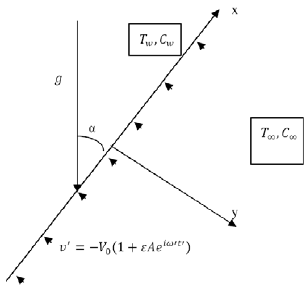
Figure 1: Geometry of the problem.
II. MATHEMATICAL FORMULATION
The unsteady free convective flow of an elastico-viscous fluid past an infinite porous inclined plate in slip flow regime has been studied. The temperature and concentration at the plate are assumed to be periodic. The suction at the plate is assumed to be  .
.
Let x'-axis be taken along the inclined plate and y'-axis be taken normal to the plate. Let α be the small angle made by the plate with the vertical so that sin α =0. Then neglecting the viscous dissipation and using Boussinesq's approximation, the governing equations of motion are:
 | (6) |
 | (7) |
 | (8) |
 | (9) |
The corresponding boundary conditions of the problem are:
 | (10) |
where σ'xy is the non dimensional form of shearing stress and it is defined as
 | (11) |
Integrating Eq. (6), we get  . -ve sign indicates that the suction is towards the plate.
. -ve sign indicates that the suction is towards the plate.
Introducing the following non-dimensional quantities

into the Eqs. (7) to (9), we get

 | (12) |
 | (13) |
 | (14) |
where A, Gr, Gc, Pr, Sc, k1, ε and ω represent the suction parameter, Grashoff number for heat transfer, Grashoff number for mass transfer, Prandtl number, Schmidt number, elastico-viscous parameter, amplitude of oscillations and frequency of oscillations respectively.
The boundary conditions of the problem in the dimensionless form are
 | (15) |
where σxy is the non-dimensional form of σ'xy defined in Eqn. (11).
III. METHOD OF SOLUTION
Assuming the small amplitude of oscillations (ε≤1), the velocity u, temperature θ and concentration  near the plate are assumed to be of the form
near the plate are assumed to be of the form
 | 16) |
Substituting (16) into Eqns. (12) to (14) and equating the like powers of the perturbation parameter ε, we get
 | (17) |
 | (18) |
 | (19) |
 | (20) |
 | (21) |
 | (22) |
The corresponding boundary conditions are
 | (23) |
The solution of Eqs. (19) to (22) are solved subject to the boundary conditions (23) and the solutions are

Now, to solve the Eqs. (17) and (18), we use another perturbation scheme by assuming k1 as perturbation parameter (k1<<1).
 | (24) |
Since k1<<1 due to small shear rate. Substituting (24) into Eqs. (17) and (18) and equating the like terms of the elastico-viscous parameter k1 and equating the like terms, we get
 | (25) |
 | (26) |
 | (28) |
 | (29) |
The relevant boundary conditions of the problem for solving the Eqs. (25) to (29) are
 | (30) |
The solutions of Eqs. (25) to (29) relevant to the boundary conditions (30) are presented as follows:
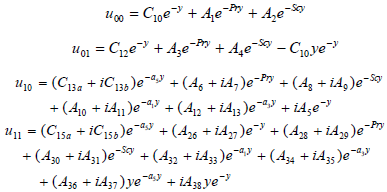
The constants of the solutions are given as follows:

IV. RESULTS AND DISCUSSIONS
The velocity profile is given by
 | (31) |
where u10=u10r+i u10i ,u11=u11r+i u11i. The shearing stress at the plate in terms of amplitude and phase is given by
 | (32) |
where σm is the mean skin-friction, |σp| and tanγ are the amplitude and phase of the skin friction.
The purpose of the present study is to bring out the effects of elastico-viscous parameter on free convective flow with heat and mass transfer past an inclined porous plate in slip flow regime under the influence of periodic temperature and concentration.
Figures 2 to 6 represent the variations of velocity profile u against y for different values of Prandtl number (Pr), Schmidt number (Sc), Grashoff number for heat transfer (Gr), Grashoff number for mass transfer (Gc), Rarefaction parameter (h) and elastico-viscous parameter (k1) with ε=0.001 and ωt=π/2.
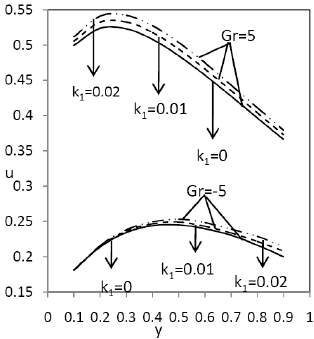
Figure 2: Variation of velocity profile u against y for Gr=5, Gr=-5, Gc=3, Pr=10, Sc=3, h=0.4, A=0.5, ε=0.001 and ωt=π/2.

Figure 3: Variation of velocity profile u against y for Gc=3, Gc=5, Gr=5, Pr=10, Sc=3, h=0.4, A=0.5, ε=0.001 and ωt=π/2.
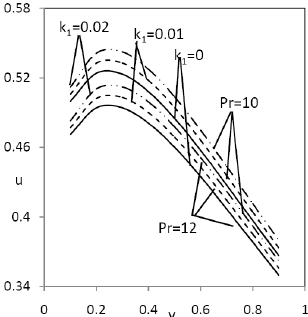
Figure 4: Variation of velocity profile u against y for Pr=10, Pr=12, Gr=5, Gc=3, Sc=3, h=0.4, A=0.5, ε=0.001 and ωt=π/2.
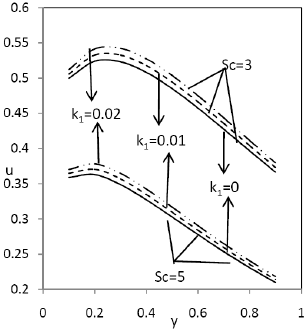
Figure 5: Variation of velocity profile u against y for Sc=3, Sc=5, Gr=5, Gc=3, Pr=10, h=0.4, A=0.5, ε=0.001 and ωt=π/2.
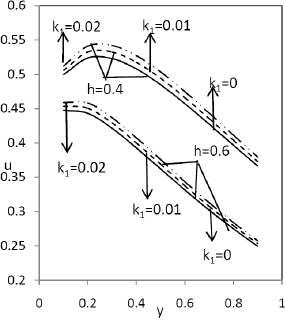
Figure 6: Variation of velocity profile u against y for h=0.4, h=0.6, Gr=5, Gc=3, Pr=10, Sc=3, A=0.5,εe=0.001 and ωt=π/2.
Here k1=0 resembles the Newtonian fluid flow and its non zero values characterize the elastico-viscous fluid flow. The results mainly discussed for Gr > 0, which corresponds the flow on cooled plate. From these figures, it is observed that velocity increases in the neighborhood of the plate but it decreases as we move far away from the plate. Also it is revealed from the figures that the velocity profile u increases due to the increase of the elastico-viscous parameter (k1=0, 0.01, 0.02).
Figure 2 shows the variations of velocity profle for Gr > 0 and Gr < 0 (i.e. flow on heated plate). The fluid flow is accelerated on the cooled plate in comparison to the flow on the heated plate.
Also, we can conclude that the fluid flow is accelerated due to the increase of free convection parameters for heat and mass transfer (Figs. 2 and 3) but it de-accelerates in case of increasing values of Rarefaction parameter (Fig. 6) Prandtl number (Fig. 4) and Schmidt number (Fig. 5).
The influence of the suction parameter is not significant on the velocity profile.
Table 1 represents the various values of the flow parameters along ε=0.001 and ωt=π/2.Tables 2 and 3 represent the variation of |σp| and tang for values of the elastico-viscous parameter with other flow parameters. It is noted that the mean skin-friction is not significantly affected by elastico-viscous parameter.
Table 1: Various values of flow parameters.
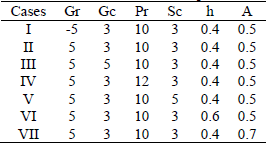
Table 2: Variation of the amplitude of the shearing stress against various cases as mentioned in Table1.

Table 3: Variations of the phase of the shearing stress against various cases as mentioned in Table 1.

From Cases I and II of Table2 it is seen that for the heated plate (Gr < 0), the amplitude of the skin friction enhances with the increasing values of parameter k1 but for the cooled plate (Gr > 0), a reverse behavior is observed. Also, we can conclude that the shearing stress increases with the increasing values of Grashoff number for mass transfer (Cases II and III) and suction parameter (Cases II and VII) but it decreases for increasing values of Prandtl number (Cases II and IV), Schmidt number (Cases II and V) and Rarefaction parameter (Cases II and VI).
The variations of phase of the skin friction are shown in Table 3. Cases I and II reveal the fact that phase decreases along with the increasing values of elastico-viscous parameter for heated plate (Gr < 0) but a reverse behavior is obtained in case of cooled plate (Gr > 0). Again, it is also noted from the table that for the cooled plate the phase increases for Newtonian fluid but it will decrease for elastico-viscous fluid along with the increasing values of the Grashoff number for mass transfer (Cases II and III). The increasing values of Prandtl number in a cooled plate lead to the increase of phase for both Newtonian and non-Newtonian fluid (Cases II and IV) but the reverse behavior is obtained in case of the increasing values of Schmidt number (Cases II and V) and Rarefaction parameter (Cases II and VI) for a cooled plate. Also, the increase of suction parameter will not create any difference in phase of the shearing stress.
The rate of heat transfer and rate of mass transfer are not significantly affected by the elastico-viscous parameter.
V. CONCLUSIONS
The fluid flow is accelerated for the flow past a cooled plate in comparison to the flow past a heated plate.
Velocity of the fluid will be enhanced by the growth of elastico-viscous parameter.
In the heated plate, the increase of elastico-viscous parameter leads to increase the amplitude of shearing stress but a reverse behavior is noted in case of cooled plate.
Rate of heat transfer and rate of mass transfer are not significantly affected by the variations of elastico-viscous parameter.
REFERENCES
1. Berezovsky, A.A., O.G. Martynenko and Y.A. Sokovishin, "Free convective heat transfer on a vertical semi infinite plate," J. Engg. Phys., 33, 32-39 (1977).
2. Chen, T.S., C.F. Yuh and A. Moutsoglu, "Combined heat and mass transfer in mixed convection along vertical and inclined plates," Int. J. Heat Mass Transfer, 23, 527-537 (1980).
3. Das, U.N., R.K. Deka and V.M. Soundalgekar, "Transient free convection flow past an infinite vertical plate with periodic temperature variation," J. Heat Transfer (ASME), 121, 1091-1094 (1999).
4. Gebhart, B. and L. Pera, "The nature of vertical convection flows resulting from the combined buoyancy effects of thermal and mass diffusion," Int. J. Heat Mass Transfer, 14, 2025-2050 (1971).
5. Hossain, M. A., S. Hussain and D.A.S. Rees, "Influence of fluctuating surface temperature and concentration on natural convection flow from a vertical flat plate," ZAMM, 81, 699-709 (2001).
6. Martynenko, O.G., A.A. Berezovsky and Y.K. Sokovishin, "Laminar free convection from a vertical plate," Int. J. Heat Mass Transfer, 27, 869-881, (1984).
7. Ostrach, S., "New aspects of natural convection heat transfer," Trans. Am. Soc. Mec. Enggrs., 75, 1287-1290 (1953).
8. Ostrach, S., "Combined natural and forced convection laminar flow and heat transfer of fluids with and without heat sources in channels with linearly varying wall temperature," NACA TN, 3141 (1954).
9. Ramanaiah, G. and G. Malarvizhi, "Free convection on a horizontal plate in a saturated porous medium with prescribed heat transfer coefficient," Acta Mech., 87, 73-80 (1991).
10. Sharma, P.K., "Influence on periodic temperature and concentration on unsteady free convective viscous incompressible flow and heat transfer past a vertical plate in slip flow regime," Mathematicas, XII, 51-62 (2005).
11. Sharma, P.K. and R.C. Chaudhary, "Effect of variable suction on transient free convective incompressible flow past a vertical plate with periodic temperature variations in slip flow regime," Emirates J. Engg. Research, 8, 33-38 (2003).
12. Sharma, P.K. and B.K. Sharma, "Influence of variable suction on unsteady free convective flow from a vertical plate and heat transfer in slip flow regime," Ganita Sandesh, 18, 55-62 (2004).
13. Soundalgekar, V.M., "Viscous dissipation effects on unsteady free convective flow past an infinite vertical porous plate with constant suction," Int. J. Heat Mass Transfer, 15, 1253-1261 (1972).
14. Soundalgekar, V.M. and P.D. Wavre, "Unsteady free convection flow past an infinite vertical plate with constant suction and mass transfer," Int. J. Heat Mass Transfer, 20, 1363-1373 (1977a).
15. Soundalgekar, V.M. and P.D. Wavre, "Unsteady free convection flow past an infinite vertical plate with variable suction and mass transfer," Int. J. Heat Mass Transfer, 20, 1375-1380 (1977b).
Received: September 7, 2010
Accepted: December 8, 2011
Recommended by subject editor: Walter Ambrosini.












